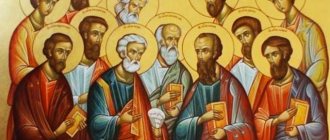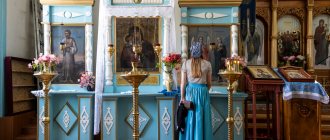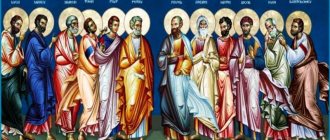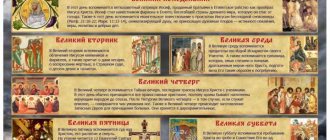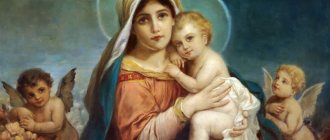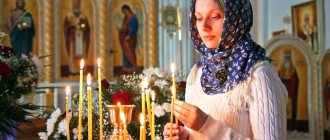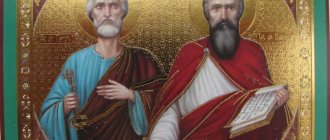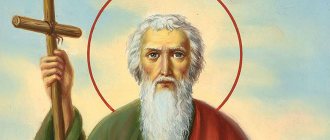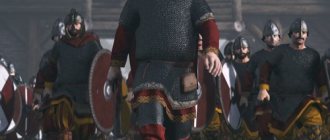Apostles are disciples of Jesus Christ, directly chosen by him and sent to serve.
In a narrow sense, the term apostle in the Bible refers to the 12 direct disciples of Jesus Christ and to St. Apostle. Paul (Christ directly chose and sent to serve after his resurrection). In a broader sense, the Apostles from seventy - 70 (in some ancient manuscripts “seventy-two”) the closest associates of Jesus Christ who preached His teachings in the 1st century (except for the twelve apostles and the Apostle Paul) are also understood.
Peter
- (Kephas - stone) that’s what the Lord called him, and his first name was Simon. Fisherman from Capernaum. Jesus stayed in his house, once healing Peter’s mother-in-law from a fever. With the permission of the Lord, Peter walked with Him for some time on the water. He was the first to believe that Jesus is the Son of the Living God, but he also denied the Teacher when he was captured by the servants of the Jewish high priest. Repentance came to Peter immediately. And the Lord forgave him, moreover, he placed him first over the other disciples. Read more…
The Twelve (brief historical data from the lives of the apostles of Jesus)
Gleb Borisov
During his earthly life, Jesus Christ gathered thousands of listeners and followers around him, among whom the 12 closest disciples especially stood out. The Christian Church calls them apostles (Greek apostolos - messenger). The life of the apostles is set out in the book of Acts, which is part of the New Testament canon. And all that is known about death is that almost everyone, except John Zebedee and Judas Iscariot, died a martyr’s death.
Stone of Faith
The Apostle Peter (Simon) was born in Bethsaida on the northern shore of Lake Galilee in the family of a simple fisherman Jonah. He was married and, together with his brother Andrei, lived in fishing. The name Peter (Petrus - from the Greek word for “stone”, “rock”, Aramaic “kephas”) was given to him by Jesus, who, having met Simon and Andrew, said to them:
“Follow me, I will make you fishers of men.”
Having become an apostle of Christ, Peter remained with him until the end of Jesus’ earthly life, becoming one of his favorite disciples. By nature, Peter was very lively and hot-tempered: it was he who wanted to walk on water in order to approach Jesus. He cut off the ear of the high priest's servant in the Garden of Gethsemane.
On the night after the arrest of Jesus, Peter, as the Teacher predicted, fearing to get himself into trouble, denied Christ three times. But later he repented and was forgiven by the Lord. On the other hand, Peter was the first to answer without hesitation to Jesus, who asked the disciples what they thought about him, “You are the Christ, the son of the living God.”
After the Ascension of the Lord, the Apostle Peter preached the teachings of Christ in different countries and performed extraordinary miracles: he raised the dead, healed the sick and infirm. According to legend (Jerome of Stridon. About famous men, Chapter I), Peter served as Bishop of Rome for 25 years (from 43 to 67 AD). However, this legend is quite late, and therefore most modern researchers believe that the Apostle Peter arrived in Rome only in the early 60s of the 1st century AD.
During Nero's persecution of Christians, the Apostle Peter was crucified on an inverted cross in 64 (according to another version in 67-68), upside down.
The latter was at the apostle’s own request, since Peter considered himself unworthy to die exactly the same death as Christ.
First Summoned
The Apostle Andrew (Andrew the First-Called) was the brother of the Apostle Peter. Christ was the first to call Andrew as a disciple, and therefore this apostle is often called the First Called. According to the Gospel of Matthew and Mark, the calling of Andrew and Peter took place near Lake Galilee. The Apostle John describes the calling of Andrew, which took place near the Jordan immediately after the baptism of Jesus (1: 35-40).
Even in his youth, Andrei decided to devote himself to serving God. Maintaining chastity, he refused to marry. Hearing that on the Jordan River John the Baptist was preaching about the coming of the Messiah and calling for repentance, Andrei left everything and went to him.
Soon the young man became John the Baptist's closest disciple.
Scripture conveys very meager information about the Apostle Andrew, but even from them one can form a completely clear picture of him. On the pages of the Gospel of John, Andrew appears twice. It is he who speaks with Jesus about the loaves and fishes before the miracle of feeding five thousand people, and also, together with the Apostle Philip, brings the Greeks to Jesus.
Until the last day of the Savior’s earthly journey, Andrei followed him. After the death of the Lord on the cross, Saint Andrew became a witness to the Resurrection and Ascension of Christ. On the day of Pentecost (that is, fifty days after the Resurrection of Jesus), the miracle of the descent of the Holy Spirit took place in Jerusalem: the apostles received the gift of healing, prophecy and the ability to speak in different languages about the deeds of Christ.
The disciples of Jesus divided among themselves the countries where they were to carry the gospel message, turning the pagans to God. By lot, Andrew received Bithynia and Propontis with the cities of Chalcedon and Byzantium, as well as the lands of Thrace and Macedonia, Scythia and Thessaly, Hellas and Achaia. And he passed through these cities and countries. Almost everywhere where the apostle found himself, the authorities met him with cruel persecution, but, supported by the strength of his faith, the Apostle Andrew worthily endured all disasters in the name of Christ. The Tale of Bygone Years tells that upon arrival in Korsun, Andrei learned that the mouth of the Dnieper was nearby, and, deciding to go to Rome, he went up the river.
Having stopped for the night in the place where Kyiv was later built, the apostle climbed the hills, blessed them and planted a cross.
After his apostolic service in the lands of future Rus', Saint Andrew visited Rome, from where he returned to the Achaian city of Patras. In this place, Saint Andrew was destined to end his earthly journey by accepting martyrdom. According to legend, in Patras he stayed with a respected man named Sosia and saved him from a serious illness, after which he converted the inhabitants of the entire city to Christianity.
The ruler in Patras at that time was a Roman proconsul named Egeates Antipates. His wife Maximilla believed in Christ after the apostle healed her from a serious illness. However, the ruler himself did not accept the apostle’s preaching, and at the same time, persecution of Christians began, which were called Nero’s persecutions.
Egeat ordered the apostle to be thrown into prison, and then ordered him to be crucified. When the servants were leading Saint Andrew to execution, the people, not understanding what he had sinned and why he was being taken to crucifixion, tried to stop the servants and free him. But the apostle begged people not to interfere with his suffering.
Noticing from a distance an oblique cross in the shape of the letter “X” placed for him, the apostle blessed him.
Egeat ordered not to nail the apostle, but, in order to prolong the suffering, he was tied, like his brother, upside down. The apostle preached from the cross for two more days. On the second day, Andrei began to pray that the Lord would accept his spirit. Thus ended the earthly journey of the Holy All-Praised Apostle Andrew the First-Called. And the oblique cross, on which the Apostle Andrew suffered a martyr’s death, has since been called the St. Andrew’s Cross. This crucifixion is considered to have taken place around the year 70.
Age-old witness
The Apostle John (John the Theologian, John Zebedee) is the author of the Gospel of John, the Book of Revelation and three epistles included in the New Testament. John was the son of Zebedee and Salome, daughter of Joseph the Betrothed. Younger brother of the Apostle James. John, like the brothers Peter and Andrey, was a fisherman. He was fishing with his father and brother Jacob when Christ called him to be a disciple. He left his father in the boat, and he and his brother followed the Savior.
The Apostle is known as the author of five books of the New Testament: the Gospel of John, the 1st, 2nd and 3rd epistles of John and the Revelation of John the Theologian (Apocalypse). The apostle received the name Theologian because of the naming of Jesus Christ in the Gospel of John as the Word of God.
On the Cross, Jesus entrusted John with the care of his mother, the Virgin Mary.
The further life of the apostle is known only from church traditions, according to which, after the Dormition of the Mother of God, John, according to the lot that fell to him, went to Ephesus and other cities of Asia Minor to preach the Gospel, taking with him his disciple Prochorus. While in the city of Ephesus, the Apostle John preached to the pagans about Christ. His preaching was accompanied by numerous and great miracles, so that the number of Christians increased every day.
During the persecution of Christians, John was taken in chains to trial in Rome. For confessing his faith in Christ, the apostle was sentenced to death by poisoning. However, after drinking a cup of deadly poison, he remained alive. Then he was assigned a new execution - a cauldron of boiling oil. But the apostle, according to legend, passed this test unharmed. Seeing this miracle, the executioners did not dare to tempt the will of the Lord any longer, and sent John the Theologian into exile on the island of Patmos, where he lived for many years.
After a long exile, the Apostle John received freedom and returned to Ephesus, where he continued to preach, teaching Christians to beware of emerging heresies. Around 95, the Apostle John wrote the Gospel, in which he commanded all Christians to love the Lord and each other, and thereby fulfill the Law of Christ.
The Apostle John lived on earth for more than 100 years, remaining the only living person to see Jesus Christ with his own eyes.
When the time of death came, John left the city with seven disciples and ordered a cross-shaped grave to be dug for him in the ground, in which he lay down. The disciples covered the apostle's face with a cloth and buried the grave. Having learned about this, the rest of the apostle’s disciples came to the place of his burial and dug it up, but did not find the body of John the Theologian in the grave.
Shrine of the Pyrenees
Apostle James (James Zebedee, James the Elder) is the elder brother of John the Theologian. Jesus called the brothers Boanerges (literally “sons of thunder”), apparently for their impetuous nature. This character was fully demonstrated when they wanted to bring fire down from heaven onto the Samaritan village, as well as in their request to give them places in the Kingdom of Heaven on the right and left sides of Jesus. Together with Peter and John, he witnessed the resurrection of Jairus's daughter, and only they allowed Jesus to witness the Transfiguration and the Battle of Gethsemane.
After the Resurrection and Ascension of Jesus, James appears in the pages of the Acts of the Apostles. He participated in the establishment of the first Christian communities. Acts also reports his death: in 44, King Herod Agrippa I “killed James, the brother of John, with the sword.”
It is worth noting that James is the only one of the apostles whose death is described on the pages of the New Testament.
The relics of Jacob were transported to Spain, to the city of Santiago de Compostela. The rediscovery of the saint's relics took place in 813. At the same time, a legend arose about the preaching of Jacob himself on the Iberian Peninsula. By the 11th century, the pilgrimage to Santiago acquired the status of the second most important pilgrimage (after the pilgrimage to the Holy Land).
When the day of remembrance of the Apostle James, July 25, falls on a Sunday, the “Year of St. James” is declared in Spain. At the end of the 20th century, the tradition of pilgrimage was revived. The capital of Chile, Santiago, is named after the Apostle James.
Family student
The Apostle Philip is mentioned in the lists of apostles in the Gospel of Matthew, Mark, Luke, and also in the Acts of the Apostles. The Gospel of John reports that Philip was from Bethsaida, from the same city as Andrew and Peter, and was called third after them. Philip brought Nathanael (Bartholomew) to Jesus. On the pages of the Gospel of John, Philip appears three more times: he talks with Jesus about bread for the multitude, brings the Greeks to Jesus, and asks Jesus to show the Father at the Last Supper.
According to Clement of Alexandria and Eusebius of Caesarea, Philip was married and had daughters.
Philip preached the Gospel in Scythia and Phrygia. For his preaching activities he was executed (crucified head down) in 87 (during the reign of the Roman Emperor Domitian) in the city of Hierapolis in Asia Minor.
The memory of the Apostle Philip is celebrated by the Catholic Church on May 3, and the Orthodox Church on November 27: on this day the Nativity fast begins, which is why it is otherwise called Philip.
An Israeli without guile
There is a unanimous opinion among biblical scholars that Nathanael mentioned in the Gospel of John is the same person as Bartholomew. Consequently, Apostle Bartholomew is one of the first disciples of Christ, called fourth after Andrew, Peter and Philip. In the scene of the calling of Nathanael-Bartholomew, he utters the famous phrase: “Can anything good come from Nazareth?”
Jesus, seeing him, said: “Here is a true Israelite, in whom there is no guile.”
According to legend, Bartholomew, together with Philip, preached in the cities of Asia Minor, especially in connection with the name of the Apostle Bartholomew, the city of Hierapolis is mentioned. According to a number of historical evidence, he also preached in Armenia, and therefore is especially revered in the Armenian Apostolic Church. He died a martyr's death: he was flayed alive.
Patron of accountants
Levi Matthew became the author of the Gospel of Matthew. Sometimes the Gospels call him Levi Alpheus, that is, the son of Alpheus. Levi Matthew was a tax collector, that is, a tax collector. In the text of the Gospel of Matthew, the apostle is called “Matthew the Publican,” which perhaps indicates the author’s humility.
After all, publicans were deeply despised by the Jews.
The Gospel of Mark and the Gospel of Luke report the calling of Matthew Levi. However, almost nothing is known about Matthew's further life. According to some sources, he preached in Ethiopia, where he was martyred; according to others, he was executed for preaching Christianity in the same Asia Minor city of Hierapolis.
The Apostle Matthew is considered the patron saint of the city of Salerno (Italy), where his remains are kept (in the Basilica of San Matteo), and also the patron saint not of tax officials, which is the first thing that comes to mind, but of accountants.
Believer twin
The Apostle Thomas was called Didymus - “twin” - he was so similar in appearance to Jesus. One of the moments of the gospel history associated with Thomas is the “confidence of Thomas.” The Gospel says that Thomas did not believe the stories of the other disciples about the Resurrection of Jesus Christ until he saw with his own eyes the wounds from the nails and the ribs of Christ pierced by a spear.
The expression “Doubting Thomas” (or “infidel”) has become a common noun for the distrustful listener.
“Thomas, who was once weaker than the other apostles in the faith,” says St. John Chrysostom, “by the grace of God became more courageous, zealous and tireless than all of them, so that he went around with his preaching almost the entire earth, not being afraid to proclaim the Word of God to the savage peoples.”
The Apostle Thomas founded Christian Churches in Palestine, Mesopotamia, Parthia, Ethiopia and India. The apostle sealed the preaching of the Gospel with martyrdom. For the conversion to Christ of the son and wife of the ruler of the Indian city of Meliapora (Melipura), the holy apostle was imprisoned, where he was tortured for a long time. After which, pierced by five spears, he died. Parts of the relics of St. Thomas the Apostle are found in India, Hungary and Mount Athos.
The island of Sao Tome and the capital of the state of Sao Tome and Principe, the city of Sao Tome, are named in honor of Thomas.
Cousin
In all four Gospels, the name of Jacob Alpheus is given in the list of apostles, but no other information is reported about him.
It is known that he was the son of Alphaeus (or Cleopas) and Mary, the sister of the Virgin Mary, and therefore a cousin of Jesus Christ.
James received the name Younger, or Lesser, so that he could be more easily distinguished from the other apostle - James the Elder, or James of Zebedee.
According to church tradition, the Apostle James is the first bishop of the Church of Jerusalem and the author of the canonical Council Epistle. The whole circle of post-biblical patericon stories about the life and martyrdom of James the Righteous is associated with it.
After the Descent of the Holy Spirit, Apostle James Alpheus made missionary travels together with Apostle Andrew the First-Called, preaching in Judea, Edessa, Gaza, and Eleutheropolis. In the Egyptian city of Ostratsin, Saint James martyrically completed his apostolic labors by death on the cross.
Not a traitor
Judas Thaddeus (Judas Jacoblev or Levvey) is the brother of James Alpheus, the son of Alpheus or Cleopas (and, accordingly, another cousin of Jesus). In the Gospel of John, Judas asks Jesus at the Last Supper about his coming resurrection.
Moreover, he is called “Judas, not Iscariot” to distinguish him from Judas the traitor.
In the Gospel of Luke and Acts, the apostle is called Judas of Jacob, which was traditionally understood as Judas, the brother of James. In the Middle Ages, the Apostle Jude was often identified with Judas, the brother of Jesus Christ mentioned in the Gospel of Mark. Nowadays, most biblical scholars consider the apostle Judas and Judas, the “brother of the Lord,” to be different persons. A certain difficulty in this regard is caused by establishing the authorship of the Epistle of Jude, included in the canon of the New Testament, which may belong to the pen of both.
According to legend, the Apostle Jude preached in Palestine, Arabia, Syria and Mesopotamia, and died a martyr’s death in Armenia in the second half of the 1st century AD. e.
Fighter against Rome
Information in the Gospels about Simon the Canaanite is extremely scarce. He is mentioned in the Gospel lists of the apostles, where he is called Simon the Zealot or Simon the Zealot to distinguish him from Simon Peter. The New Testament does not provide any other information about the apostle. The name Canaanite, which has sometimes been erroneously interpreted by biblical scholars as “from the city of Cana,” actually has the same meaning in Hebrew as the Greek word “zealot,” “zealot.” Either this was the apostle’s own nickname, or it could mean his belonging to the political-religious movement of the Zealots (Zealots) - irreconcilable fighters against Roman rule.
According to legend, the holy Apostle Simon preached the teachings of Christ in Judea, Egypt and Libya. Perhaps he preached together with the Apostle Judas Thaddeus in Persia. There is information (unconfirmed) about the visit of the Apostle Simon to Britain.
According to legend, the apostle suffered a martyr's death on the Black Sea coast of the Caucasus: he was sawed alive with a saw.
He was buried in the city of Nikopsia, the location of which is also controversial. According to the official theory, this city is the current New Athos in Abkhazia; according to another (more probable), it was located on the site of the current village of Novomikhailovsky in the Krasnodar Territory. In the 19th century, on the supposed site of the exploits of the apostle, near the Apsara Mountain, the New Athos Monastery of Simon the Canaanite was built.
Thirteenth Apostle
Judas Iscariot (Yehuda ish-Krayot, “Yehuda of Kerioth”) is the son of Simon, the apostle who betrayed Jesus Christ. Judas received the nickname “Iscariot” among the apostles to distinguish him from another disciple of Christ, the son of James, Judas, nicknamed Thaddeus. Referring to the geographical location of the city of Kerioth (Krayot), most researchers agree that Iscariot was the only representative of the tribe of Judah among the apostles.
After Jesus Christ was sentenced to crucifixion, Judas, who betrayed him, returned 30 pieces of silver to the high priests and elders, saying: “I have sinned by betraying innocent blood.” They answered: “What is that to us?” Leaving the pieces of silver in the temple, Judas left and hanged himself.
Legend has it that Judas hanged himself on an aspen tree, which since then began to tremble with horror at the slightest breeze, remembering the traitor. However, it acquired the properties of a magical weapon capable of killing vampires.
After the betrayal and suicide of Judas Iscariot, Jesus' disciples decided to choose a new apostle to replace Judas. They chose two candidates: “Joseph, called Barsaba, who was called Justus, and Matthias,” and, having prayed to God to indicate whom to make an apostle, they cast lots. The lot fell to Matthias.
Deputy by lot
Apostle Matthias was born in Bethlehem, where from early childhood he studied the Law of God from the sacred books under the guidance of Saint Simeon the God-Receiver. Matthias believed in the Messiah, followed him relentlessly, and was chosen as one of the 70 disciples whom the Lord “sent out two by two before Him.”
After the Descent of the Holy Spirit, the Apostle Matthias preached the Gospel in Jerusalem and Judea along with the other apostles. From Jerusalem with Peter and Andrew he went to Syrian Antioch, was in the Cappadocian city of Tyana and in Sinope.
Here Apostle Matthias was imprisoned, from which he was miraculously released by Apostle Andrew the First-Called.
Then Matthias went to Amasia and Pontic Ethiopia (present-day Western Georgia), repeatedly being exposed to mortal danger.
He performed great miracles in the Name of the Lord Jesus and converted many people to faith in Christ. The Jewish high priest Anan, who hated Christ, who had previously given the command to throw James, the brother of the Lord, from the heights of the temple, ordered the Apostle Matthias to be taken and presented to the Sanhedrin in Jerusalem for trial.
Around the year 63, Matthias was condemned to death by stoning. When Saint Matthias was already dead, the Jews, hiding the crime, cut off his head as an opponent of Caesar. According to other sources, the Apostle Matthias was crucified on the cross. And according to the third, least reliable, he died a natural death in Colchis.
Strana.ru
John the Theologian (Zevdeev)
(Theologian) - author of the fourth Gospel and other books of the New Testament. He is nicknamed the Theologian because in his Gospel there is a lot of direct speech of Christ, the Word of God. Like Andrei, before meeting Jesus he was a disciple of John the Baptist. John, the youngest and most beloved disciple of Christ. It was he who reclined on the Savior’s shoulder during the Last Supper. He was the only one of the disciples who dared to be on Calvary during the Crucifixion, and before that he was next to the Lord during interrogations by the high priest and Pontius Pilate. Jesus bequeathed to him to take care of the Mother of God. After the Teacher left earthly life, John took Mary to his house.
The only apostle who died a natural death and in old age. Read more…
Apostles from seventy (two)
The election of 70 disciples * was in the last year of Jesus Christ’s life on earth, after which he gave them instructions similar to those he gave to his twelve apostles.
Many of these disciples departed from Jesus Christ, and therefore, among the seventy apostles, the Christian Church included other preachers of the Gospel, who were disciples of the twelve apostles and the Apostle Paul.
The names of the apostles of the seventy are not found in the Gospels. The names of almost all of them are known from the Acts of the Holy Apostles and the letters of the Apostle Paul. This is how the names of the first seven deacons chosen by the twelve apostles are known. However, nowhere are they directly called apostles. Their lists were compiled several centuries after the gospel events and differ among different authors.
| # | Name | Mentions in NT |
| 1 | Jacob the Lord's brother | Matthew 13:55; Mark 15:40; Mark 6:3; Acts 12:17; Acts 15:13; 1 Cor 15:7; Gal 1:19; Gal 2:9-12; Last Jacob. |
| 2 | Mark (evangelist) | 1 Peter 5:13 |
| 3 | Luke (evangelist) | Col 4:14 |
| 4 | Cleopas, brother of St. Joseph the Betrothed | Luke 24:18; John 19:25 |
| 5 | Simeon kinsman of the Lord | Matthew 13:55? |
| 6 | Barnabas (Josiah) | Acts 4:36 |
| 7 | Jesus-Just (Josius, Joseph, Barsabas) | Acts 1:23 |
| 8 | Thaddeus | Not mentioned |
| 9 | Ananias (Ananias) | Acts 22:12 |
| 10 | Stephen the First Martyr | Acts 6:5, ; |
| 11 | Philip | Acts 6:5; Acts 8:26; Acts 21:8 |
| 12 | Prokhor | Acts 6:5 |
| 13 | Nikanor | Acts 6:5 |
| 14 | Timon | Acts 6:5 |
| 15 | Parmen | Acts 6:5 |
| 16 | Timofey | Acts 16:1-3; Rom 16:21; 1 Tim 1:2 2 Tim 1:2 |
| 17 | Titus | 2 Cor 8:6, , ; Gal 2:1; Titus 1:4 |
| 18 | Philemon | Flm 1:1 |
| 19 | Onesimus | Col 4:9; Flm 1:10 |
| 20 | Epaphras | Col 1:7; Col 4:12; Flm 1:23 |
| 21 | Arkhippus | Col 4:17; Flm 1:2 |
| 22 | Force | Acts 15:22, ; Acts 16:25 |
| 23 | Silouan | 1 Peter 5:12; 1 Thessalonians 1:1 |
| 24 | Kriskent (Krisk) | 2 Tim 4:10 |
| 25 | Crisp | 2 Tim 4:10 |
| 26 | Epenet | Rom 16:5 |
| 27 | Andronik | Rom 16:7 |
| 28 | Stachy | Rom 16:9 |
| 29 | Amply | Rom 16:8 |
| 30 | Urvan | Rom 16:9 |
| 31 | Narkiss | Rom 16:11 |
| 32 | Apellius (Apel, Apelles) | Rome 16:10 |
| 33 | Aristobulus | Rome 16:10 |
| 34 | Herodion (Rodion) | Rom 16:11 |
| 35 | Agave | Acts 11:28; Acts 21:10-11 |
| 36 | Rufus | Mark 15:21; Rom 16:13 |
| 37 | Asyncrit | Rom 16:14 |
| 38 | Phlegont | Rom 16:14 |
| 39 | Erma (Erm) | Rom 16:14 |
| 40 | Patrov (Patrovasiy) | Rom 16:14 |
| 41 | Ermin (Yermiy) | Rom 16:14 |
| 42 | Lin | 2 Tim 4:21 |
| 43 | Gaiy (Gai) | Acts 19:29; Acts 20:4; Rom 16:23; |
| 44 | Philologist | Rome 16:15 |
| 45 | Lukiy | Acts 13:1 |
| 46 | Jason | Acts 17:5-10; Rom 16:21 |
| 47 | Sosipater | Acts 20:4 |
| 48 | Olympasios (Olympanus, Olympus) | Rome 16:15 |
| 49 | Tertius | Rom 16:22 |
| 50 | Erast | Acts 19:22; Rom 16:23 |
| 51 | Quart | Rom 16:23 |
| 52 | Evod | Not mentioned |
| 53 | Onesiphorus | 2 Tim 1:16 |
| 54 | Clement | Phil 4:3 |
| 55 | Sosthenes | Acts 18:17; 1 Cor 1:1 |
| 56 | Apollos Bishop of Caesarea (Smyrna) | Acts 18:24; Acts 19:1; 1 Cor 1:12; 1 Cor 3:22; Titus 3:13 |
| 57 | Tychicus, Bishop of Colophon (Chalcedon) | Acts 20:4 |
| 58 | Epaphroditus | Phil 2:25; Phil 4:18 |
| 59 | Carp | 2 Tim 4:13 |
| 60 | Kodrat | Not mentioned |
| 61 | Mark John, nephew of Barnabas | Acts 15:37; Acts 13:5 |
| 62 | Zina | Titus 3:13 |
| 63 | Aristarchus Bishop of Amasia | Acts 19:29; Acts 20:4; Acts 27:2; Col 4:10 |
| 64 | Pud | 2 Tim 4:21 |
| 65 | Trofim | Acts 20:4 |
| 66 | Mark | Col 4:10 |
| 67 | Arfema (Artema, Artem) | Titus 3:12 |
| 68 | Akila (Akhila) | Acts 18:2; Rom 16:3-5; 1 Cor 16:19 |
| 69 | Fortunatus | 1 Cor 16:17 |
| 70 | Akhaik | 1 Cor 16:17 |
| 71 | Dionysius the Areopagite | Acts 17:34 |
| 72 | Simeon Niger | Acts 13:1 |
Thomas
— known to everyone by the nickname “The Unbeliever.” He doubted the Resurrection of the Lord, but soon Christ appeared to the disciples and invited Thomas to put his finger into his wounds, after which Thomas finally believed what had happened. However, distrust was only a detail in Thomas’s character - stubborn and decisive. When danger loomed over Jesus, Thomas, contrary to warnings, decided to return to Jerusalem. It was Thomas who suggested that the apostles go with the Teacher, even to death. He confesses Jesus as God for the first time. Read more…
Veneration of the Apostles
The veneration of the apostles was one of the starting points for the cult of saints in general. Their holiness was certified by Christ himself, who asked God the Father during the Last Supper to “keep them in Your name” (John 17:11); the apostles, thus, acted as an example of humanity saved by their faith. The establishment of the celebration of the memory of the apostles dates back to ancient times. The celebration of the memory of the apostles Peter and Paul in Rome on June 29, 258 is mentioned in the mid-century calendar. The celebration of their memory on this day is common to all Christian denominations. Quite early in the remembrance of the apostles, a special fast is established, ending on June 29. S - cent. In the Eastern Church on June 30, the celebration of the Council of the Twelve Apostles is established. In the Jerusalem church at least since c. The celebration of the Apostle James, the brother of the Lord, and the Apostle John the Theologian is known. Since the apostles headed the church, the veneration of the saints is in continuity with the veneration of the apostles. Since most of the apostles ended their lives as martyrs, the veneration of martyrs is also associated with the veneration of the apostles. Thus, in the apostles different types of holiness find simultaneous fulfillment, and the later veneration of different orders of saints is combined, as in its source, with the veneration of the apostles. This connection is also reflected in the iconography of the apostles: they can be depicted in episcopal vestments; at the same time, images of the procession of the apostles in golden crowns, which can be interpreted as martyr’s crowns, are possible.
Iconography
The first images of the apostles appeared in the third century. There are two iconographic images that are used when painting icons depicting saints:
- Byzantine. This icon differs from the others in that the apostles are shown in full growth. Each of them holds scrolls on which the text of Christian teaching is written.
- Old Russian. Russian icon painters depicted saints in the form of grape vines. At the top is the Savior, and at the bottom are his disciples.
Veneration and ecclesiastical significance
Nowadays, the holy apostles are considered an example to be imitated. Even now people remember their devotion, exploits and good deeds. They are glorified in prayers and even holidays are held that are dedicated to them. Most often, veneration resembles the veneration of saints. People bow to their relics to pray and ask for help. Orthodox Christians also worship icons and erect chapels and church buildings in their honor.
Prayer before the icon of the 12 Apostles
Almighty Master, Lord our God, who chose His beloved disciples and Apostles to preach salvation to the whole world, giving them the power to forgive sins, accept their petitions for the human race, and judge with them, those same ones who are Your friends, who are very honest to us, We dare, in our unworthiness, to bring you into intercession, which will greatly advance the salvation of our souls, praying for them earnestly. Holy Chief Apostles Peter and Paul, Evangelists of Christ John the Theologian and Matthew, First-Called Disciple Andrew, who blessed Russia with the planting of the Cross, Holy Apostles James, the brother of the Lord, with the other James, Philip, Bartholomew, Thomas, Simon, Judas and Matthias! All holy apostles of God's choice, most noble servants of Christ, eradicators of godlessness and planters of the true faith, help us through your powerful intercession before the Lord to get rid of all evil and enemy flattery, to firmly preserve the Orthodox faith devoted to you, in which, through your intercession, neither wounds, nor rebuke, nor pestilence, we will not be belittled by any wrath from the Creator, but let us live a peaceful life here and may we be honored to see good things on the land of the living, glorifying the Father and the Son and the Holy Spirit, the one God glorified and worshiped in the Trinity, now and ever and unto the ages of ages. Amen.
One can only admire the immeasurable strength of spirit that all the apostles showed. And if humanity has accepted their enormous sacrifice, it is necessary to always remember it and be worthy of it.
If you find an error, please select a piece of text and press Ctrl+Enter.
